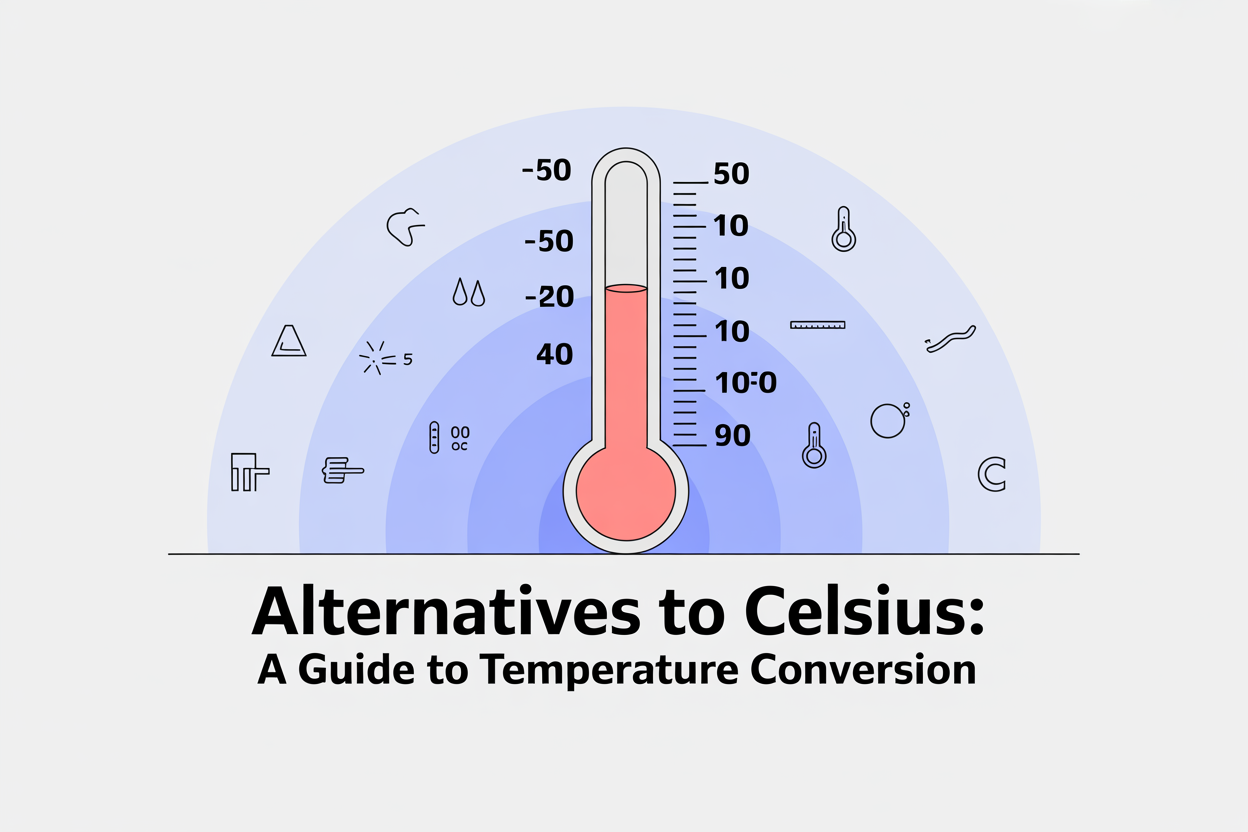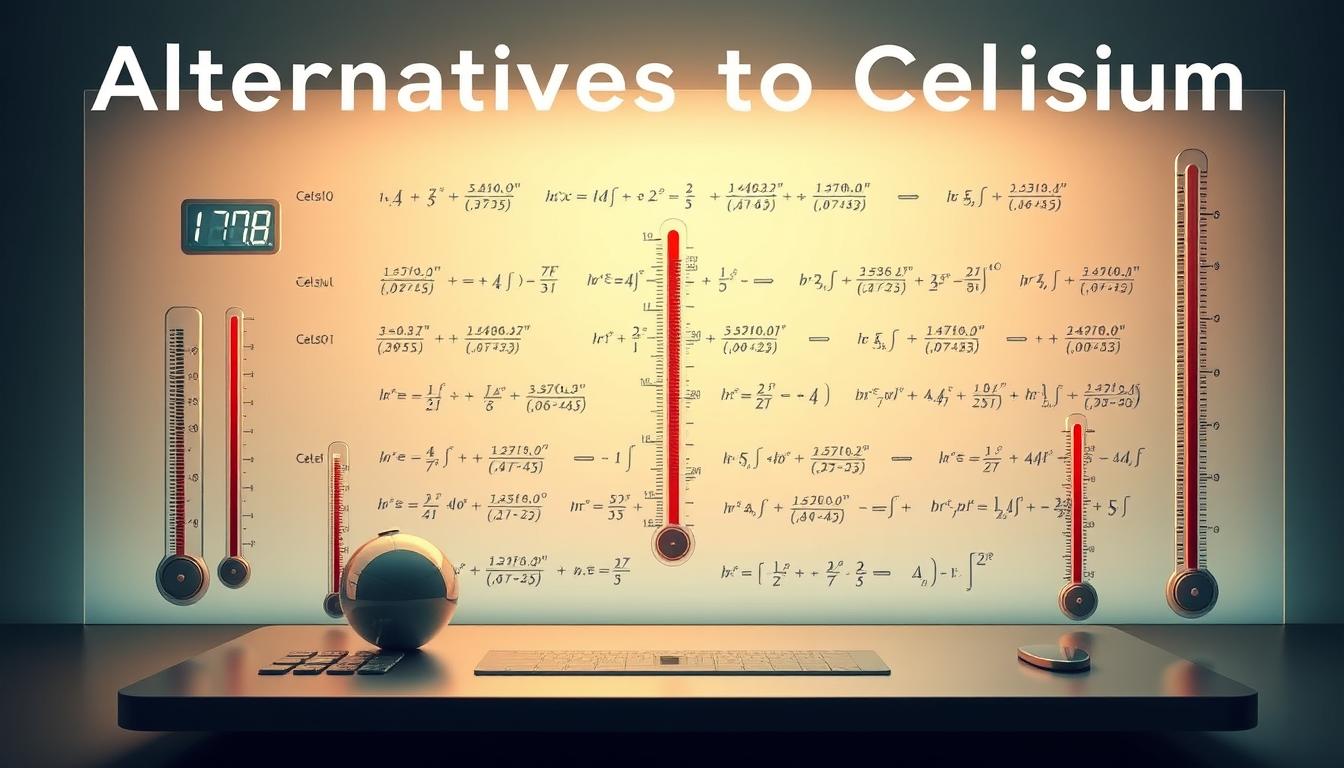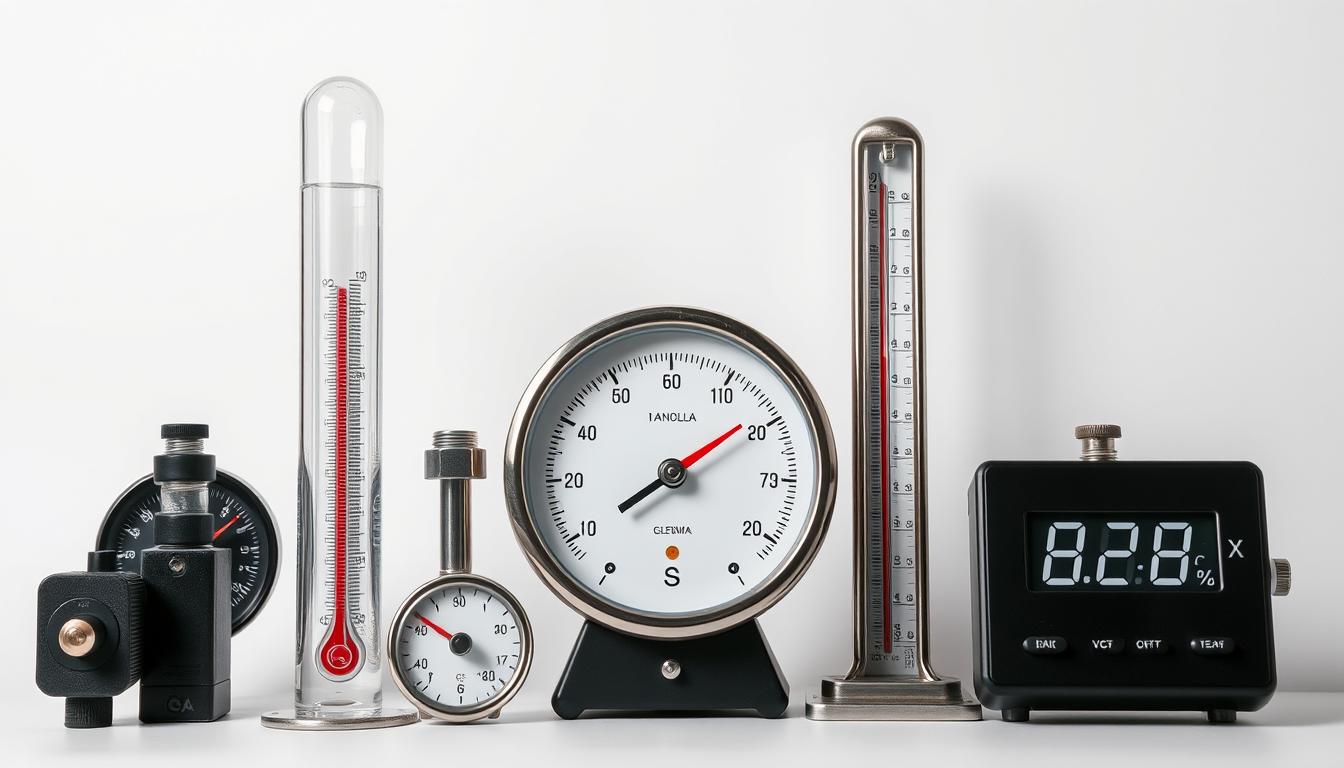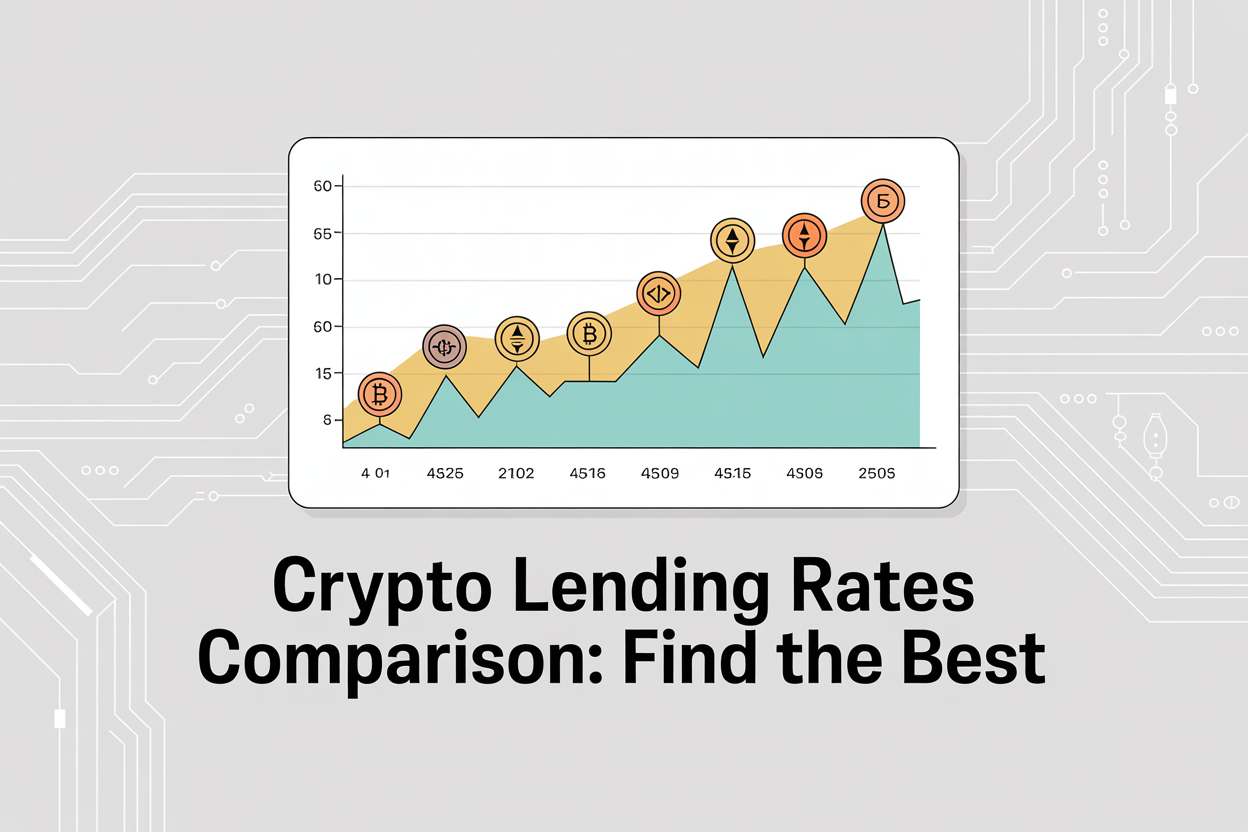Now Reading: Alternatives to Celsius: A Guide to Temperature Conversion
- 01
Alternatives to Celsius: A Guide to Temperature Conversion
Alternatives to Celsius: A Guide to Temperature Conversion

Temperature conversion is key in science and daily life. We need to switch between different scales because of how temperature is measured worldwide. The Celsius scale is common, but Fahrenheit and Kelvin are used in certain areas too.
The metric system makes temperature measurement consistent. But knowing how to convert between scales is important. This is true for weather forecasting, cooking, and scientific studies.

Key Takeaways
- Understanding temperature conversion is vital for various applications.
- The Celsius scale is widely used, but other scales like Fahrenheit and Kelvin are also important.
- The metric system standardizes temperature measurement.
- Temperature conversion is crucial in fields like meteorology and scientific research.
- Accurate temperature conversion ensures precise communication and calculation.
Understanding Temperature Measurement
Temperature is key in our daily lives. Its measurement has changed a lot over time. It shows how hot or cold something is by measuring its thermal energy.
The Concept of Temperature
Temperature is a basic idea in physics. It shows the average energy of particles in a substance. It’s important for weather measurement and converting temperature between units.
Why We Need Different Temperature Scales
There are many reasons for different temperature scales. Knowing these reasons helps us understand temperature measurement better.
Scientific Requirements
Science needs different scales for different reasons. For example, the Kelvin scale is used in research because it starts at absolute zero. Key needs include:
- Precision in extreme temperatures
- Compatibility with specific scientific equations
- Ease of use in calculations
Cultural and Historical Factors
Culture and history also shaped temperature scales. The Fahrenheit scale was common in the U.S., while Celsius was used in Europe. These choices reflect historical preferences and the spread of the metric system.
The History of Temperature Scales
The history of temperature scales is long and interesting. It spans centuries. People have always wanted to measure temperature accurately, leading to many scales today.
Origins of Temperature Measurement
Ancient civilizations first tried to measure temperature. They used simple ways to feel the heat. As science grew, so did the need for better tools.
In the 17th century, the first thermometers were made. This was a big step in measuring temperature.
Development of Modern Temperature Scales
In the 18th century, modern scales started to form. Daniel Gabriel Fahrenheit created the Fahrenheit scale, popular in the U.S. Anders Celsius made the Celsius scale, favored by scientists.
Converting between these scales became key for science and global talks. Knowing how to switch Fahrenheit to Celsius is still useful today.
Evolution of Standardization
New scales, like the Kelvin scale, were developed later. The Kelvin scale is used in science for absolute temperatures. It’s important for some calculations.
Standardizing temperature scales helped the world talk and work together. This is true in fields like weather, science, and business. For more on standardization, check out cryptomaximal.com.
Celsius Scale: The Metric Standard
The Celsius scale is key in the metric system, used worldwide for temperature. It has two fixed points: 0 degrees for water’s freezing point and 100 degrees for its boiling point, at standard pressure.
How Celsius Works
The Celsius scale splits the water freezing to boiling range into 100 parts. This makes it easy and clear. Its simplicity is why it’s used so much in science and daily life.
Where Celsius is Used Globally
Most countries use Celsius for temperature, especially in science and tech. It’s the top choice for international talks and research.
Advantages and Limitations
The Celsius scale is advantageous because it’s simple and fits with the metric system. Yet, it might not be as clear for some everyday uses in cultures. Knowing its pros and cons is key for accurate temperature reading.
Fahrenheit: The Primary Alternative to Celsius
Celsius is used worldwide, but Fahrenheit is big in the United States. Knowing Fahrenheit is key for daily tasks like checking the weather or body temperature.
The Basics of Fahrenheit
The Fahrenheit scale sets water’s freezing at 32 degrees and boiling at 212 degrees. Gabriel Fahrenheit created it in the 1700s.
Usage Around the World
Most countries use Celsius, but the US sticks with Fahrenheit. It’s common in weather reports and daily life.
Practical Applications
Fahrenheit is used in many ways every day. It’s especially seen in:
Weather Forecasting
In the US, weather is reported in Fahrenheit. It’s what people are used to and helps in predicting the weather.
Body Temperature Measurement
In the US, body temperature is usually measured in Fahrenheit. A normal body temperature is about 98.6°F.
Fahrenheit’s use shows it’s a strong alternative to Celsius. Even though Celsius is more common, Fahrenheit’s role in certain areas is clear.
The Kelvin Scale: Absolute Temperature
The Kelvin scale is a key tool for measuring temperature. It provides a zero point for temperature, changing how we do science. It’s used in many fields of study.
Scientific Principles Behind Kelvin
The Kelvin scale is based on absolute zero. This is the point where particles barely move. It’s 0 K. This makes the Kelvin scale great for science because it doesn’t have negative values.
Understanding temperature is important. It helps us keep data safe, like in crypto wallets. Just like how cold storage keeps assets safe, controlling temperature is key in science.
Relationship to Celsius
The Kelvin scale is close to the Celsius scale. They differ by 273.15. To go from Celsius to Kelvin, just add 273.15 to the Celsius reading. This makes switching between scales easy.
When and Why to Use Kelvin
Kelvin is best for scientific research and engineering. It’s needed when you need to control temperature precisely.
Scientific Research
In science, Kelvin helps measure temperature accurately. It’s perfect for low-temperature experiments. It’s great for figuring out thermodynamic properties.
Engineering Applications
In engineering, Kelvin is used for precise temperature control. It’s used in cryogenic systems and materials science. Using Kelvin makes sure temperature calculations are correct.
Other Temperature Scales: Rankine, Réaumur, and More
There’s more to temperature measurement than just Celsius and Fahrenheit. Other scales have been used in history and special cases. Each has its own story and use.
Lesser-Known Temperature Scales
Many temperature scales have been created over time. The Rankine, Réaumur, and Delisle scales are examples. Each has its own traits and purposes.
Historical and Specialized Applications
These scales have been used in different times and fields. Knowing about them helps us understand their importance.
Rankine Scale
The Rankine scale is used in engineering and science in the U.S. It’s like the Kelvin scale but uses Fahrenheit. This makes it useful in certain areas.
Réaumur Scale
The Réaumur scale was once popular in France and Russia. It made water’s freezing point 0°Ré and boiling point 80°Ré. Though not used much now, it’s still important in history.
Delisle Scale
The Delisle scale was used in the past. It made water’s boiling point 0°De and freezing point 150°De. It was used in some 18th-century science.

Even though these scales are not used much today, they helped us understand temperature. They show the variety in measuring temperature.
Converting Between Celsius and Fahrenheit
Learning to convert Celsius to Fahrenheit is useful for travel, cooking, and science. It’s key for anyone who moves between countries, cooks, or does research. Knowing how to switch between these scales is crucial.
The Standard Conversion Formula
To convert Celsius to Fahrenheit, use °F = (°C × 9/5) + 32. For Fahrenheit to Celsius, it’s °C = (°F – 32) × 5/9. These formulas give precise conversions.
Simplified Methods for Quick Conversion
For a fast estimate, try the “Double and Add 30” rule. It’s a quick way to convert Celsius to Fahrenheit, even if it’s not exact.
The “Double and Add 30” Method
To use this method, double the Celsius temperature and add 30. For example, 20°C becomes 40, then add 30 for about 70°F. The real conversion is 68°F, so it’s pretty close.
Key Temperature Benchmarks
Remember these key temperatures for quick conversions: 0°C = 32°F (water freezes), 100°C = 212°F (water boils), and 37°C = 98.6°F (human body temperature).
Common Temperature Reference Points
It’s helpful to know common temperature points. For example, a room temperature of 20-22°C (68-72°F) is comfortable. You can find more guides and tools online, like this article, which offers more tips.
Converting to and from Kelvin
Learning to convert to and from Kelvin is key in science, especially in physics and chemistry. The Kelvin scale is a temperature scale that starts at absolute zero. It’s a crucial reference point.
Celsius to Kelvin Conversion
To change Celsius to Kelvin, just add 273.15 to the Celsius number. This simple step is vital in science when you need absolute temperature.
Formula: K = °C + 273.15
Fahrenheit to Kelvin Conversion
To convert Fahrenheit to Kelvin, you first change Fahrenheit to Celsius. Then, you change Celsius to Kelvin. This is important in science to standardize data from different sources.
Formula: K = (°F – 32) × 5/9 + 273.15
Practical Examples in Science
The Kelvin scale is used in many scientific areas, like gas laws and thermodynamics.
Gas Laws
In gas laws, like Charles’s Law, the Kelvin scale is used. It gives an absolute reference point. For example, a gas’s volume is directly related to its temperature in Kelvin.
Thermodynamics
In thermodynamics, the Kelvin scale is key for figuring out heat engine and refrigerator efficiency. It helps in precise temperature difference and absolute temperature calculations.
Knowing how to convert to and from Kelvin is essential for scientists and engineers working with temperature-sensitive data.
Digital Tools for Temperature Conversion
Gone are the days of manual calculations; digital tools now make temperature conversion easy. Technology has advanced, bringing various digital tools to simplify temperature conversions between scales.
Smartphone Apps for Temperature Conversion
Smartphone apps are a convenient way to convert temperatures. They work on both iOS and Android devices. Apps like Convert Units and Temperature Converter make conversions quick and easy.
Online Conversion Calculators
Online conversion calculators are a good option if you don’t want to download apps. Sites like UnitConverters and ConversionCalculator offer free tools. They can be used from any device with internet.
Smart Home Devices with Temperature Features
Smart home devices are part of our daily lives, making temperature conversions easier. These include voice assistants and smart thermostats.
Voice Assistants
Voice assistants like Amazon Alexa and Google Assistant can convert temperatures with voice commands. This is a hands-free and convenient option.
Smart Thermostats
Smart thermostats, such as Nest and Ecobee, control your home’s temperature. They also give temperature readings in different units, sometimes converting between Celsius and Fahrenheit.

These digital tools have made temperature conversion more accessible and user-friendly. They cater to various needs and preferences.
Temperature Conversion in Weather Forecasting
Temperature conversion is key in weather forecasting. It helps meteorologists predict weather patterns accurately. Weather services worldwide use different formats for temperature data. It’s important to know how to switch between these scales.
How Weather Services Present Temperature
Weather services show temperature data in the local scale of their area. In the U.S., it’s Fahrenheit. But most countries use Celsius. Knowing the scale used is vital for correct weather forecast interpretation.
Understanding International Weather Reports
When you travel or check international weather, knowing temperature conversions is crucial. For example, a European weather report might be in Celsius. You’ll need to convert it to Fahrenheit if you’re used to that scale.
Converting Weather Forecasts While Traveling
Travelers often need to convert temperatures to understand local weather. Here are some tips:
- Check the local temperature scale used at your destination.
- Use a temperature conversion tool or app to convert temperatures quickly.
- Understand common temperature references in both Celsius and Fahrenheit.
Hot Weather Conversion Tips
When traveling to hot places, knowing the temperature in your familiar scale is helpful. For example, 30°C is the same as 86°F, which is very hot.
Cold Weather Conversion Tips
In cold places, converting temperatures helps you dress right. For example, -10°C is the same as 14°F, which means it’s very cold.
By learning temperature conversion, travelers can better understand weather forecasts. This helps them plan and ensures a safer, more comfortable trip.
Temperature Scales in Cooking and Baking
Cooking and baking need precision. Knowing temperature scales is key to making the perfect dish. Whether you’re following a recipe or trying new flavors, controlling temperature is crucial.
Oven Temperature Conversions
Oven temperature conversions are important for cooks. They help adapt recipes from one scale to another. Most ovens let you choose between Celsius and Fahrenheit, but knowing how to convert is still vital.
Standard Oven Settings
Oven settings vary between Celsius and Fahrenheit. For example, a moderate oven is set at 180°C or 350°F. Knowing these conversions helps adjust recipes.
- 160°C = 325°F (Low oven)
- 180°C = 350°F (Moderate oven)
- 200°C = 400°F (Hot oven)
Convection Adjustments
Convection ovens need temperature adjustments. You can lower the temperature by about 20°C or 30°F. This helps achieve the same results as a conventional oven.
Food Safety Temperature Guidelines Across Scales
Food safety is critical in cooking. Temperature is key to preventing illnesses. Knowing safe internal temperatures for foods is essential, no matter the scale.
Safe Internal Temperatures:
- Poultry: 74°C / 165°F
- Ground Meats: 71°C / 160°F
- Beef, Pork, Lamb: 63°C / 145°F (medium-rare)
International Recipe Adaptation
Adapting international recipes means converting temperatures. Whether converting a European recipe to Fahrenheit or adjusting Asian cooking temperatures, understanding these conversions is key.
European to American Conversions
European recipes use Celsius, while American recipes use Fahrenheit. Knowing conversion formulas or having a reliable chart is essential for adapting recipes accurately.
Asian Cooking Temperature Standards
Asian cooking uses high-heat techniques like stir-frying. Precise temperature control is necessary. Understanding Asian recipe temperature scales and how to convert them is vital for authentic flavors.
Mastering temperature conversions and food safety guidelines lets cooks and bakers confidently explore international recipes. This ensures delicious and safe meals every time.
Scientific and Industrial Applications of Different Scales
Getting the right temperature is key in many areas like research, making things, and health care. The scale used can really affect how accurate and consistent these measurements are.
Laboratory Temperature Standards
In science labs, strict temperature rules are followed to make sure results are reliable. The Kelvin scale is often chosen because it starts at absolute zero. This is important for controlling temperatures in experiments.
Depending on what they’re doing, labs might use the Celsius scale for everyday tasks. But for measuring heat in a scientific way, the Kelvin scale is better.
Industrial Process Temperature Management
Places like factories, chemical plants, and food makers need to manage temperature well. They use different scales based on what they’re doing and where they are. For example, in the U.S., Fahrenheit is still used in some industrial settings.
Using the right temperature scale helps keep products safe and meets rules. Systems for controlling temperature can switch between scales to meet different needs.
Medical Temperature Measurements
In hospitals, knowing a person’s body temperature is very important for diagnosing and caring for them. The Celsius scale is used worldwide, but in the U.S., Fahrenheit is still used too.
Clinical Standards
Thermometers in clinics are set to show temperatures in the scale used by the hospital. Most medical tools show temperatures in Celsius, following global standards.
Home Health Monitoring
At home, you can find thermometers in both Celsius and Fahrenheit. This lets people choose what they prefer. Digital thermometers can switch between scales, making it easier for users.

Common Misconceptions About Temperature Scales
Temperature scales are key in our daily lives, but many get them wrong. It’s important to know about them for cooking, weather, and science. We’ll clear up some common mistakes and explain the different scales.
The Myth of Fahrenheit’s Body Temperature Basis
Many think the Fahrenheit scale is based on human body temperature. While Gabriel Fahrenheit did start with body temperature, it was later changed. The real basis was a mix of ice, water, and salt, the lowest temperature known back then.
Confusion Between Heat and Temperature
People often mix up heat and temperature. But they’re not the same. Temperature is about the energy of particles in a substance. Heat is energy moving from one thing to another because of temperature difference. Knowing this helps in cooking, science, and engineering.
Misunderstandings About Absolute Zero
Absolute zero is often misunderstood. Some think it’s the coldest point, but it has deep theoretical meanings.
Physical Limitations
Getting to absolute zero is impossible, thanks to the third law of thermodynamics. As you near absolute zero, it’s hard to remove all entropy from a system.
Theoretical Implications
Absolute zero changes how we see quantum mechanics and matter at very low temperatures. Near absolute zero, scientists have found superconductivity and superfluidity.
By fixing these misconceptions, we understand temperature scales better. Accurate temperature measurement and conversion are vital in many areas, from cooking to scientific research.
Mastering Temperature Conversion in Your Daily Life
Learning to convert temperatures can make your daily life easier. It’s useful for cooking, checking the weather, or working in science. Knowing how to switch between Celsius, Fahrenheit, and Kelvin makes it simple.
Get to know the standard conversion formulas. Use digital tools like smartphone apps or online calculators to convert temperatures fast and right. This skill is great for traveling or using international recipes and weather forecasts.
Temperature conversion has many uses in daily life. It helps with setting your thermostat or understanding scientific data. With this guide, you’ll be able to handle temperature tasks with confidence and make smart choices.
FAQ
What is the difference between Celsius and Fahrenheit temperature scales?
The Celsius scale uses water’s freezing and boiling points as 0 and 100 degrees. The Fahrenheit scale sets these points at 32 and 212 degrees.
Why do some countries use Fahrenheit while others use Celsius?
Countries use different temperature scales for historical and cultural reasons. The U.S. mainly uses Fahrenheit, while most of the world uses Celsius.
How do I convert Celsius to Fahrenheit?
To convert Celsius to Fahrenheit, use this formula: °F = (°C × 9/5) + 32. For instance, 30°C is 86°F.
What is the Kelvin scale used for?
The Kelvin scale is used in science and engineering. It’s an absolute temperature scale, starting at absolute zero.
Can I use online tools for temperature conversion?
Yes, online tools and apps can quickly and accurately convert temperatures between scales.
Why is temperature conversion important in cooking and baking?
In cooking and baking, accurate temperature conversion is key. It ensures dishes are cooked correctly, affecting the taste and texture.
How does temperature conversion apply to weather forecasting?
Weather forecasting often converts temperatures between Celsius and Fahrenheit. This helps cater to different regions and audiences.
What are some common misconceptions about temperature scales?
Some think the Fahrenheit scale is based on body temperature. Another mistake is confusing heat with temperature, as they are different.
Are there temperature scales other than Celsius, Fahrenheit, and Kelvin?
Yes, there are other scales like Rankine, Réaumur, and Delisle. Each has its own historical or specialized use.
How do I convert Fahrenheit to Kelvin?
First, convert Fahrenheit to Celsius: °C = (°F – 32) × 5/9. Then, add 273.15 to convert Celsius to Kelvin.















